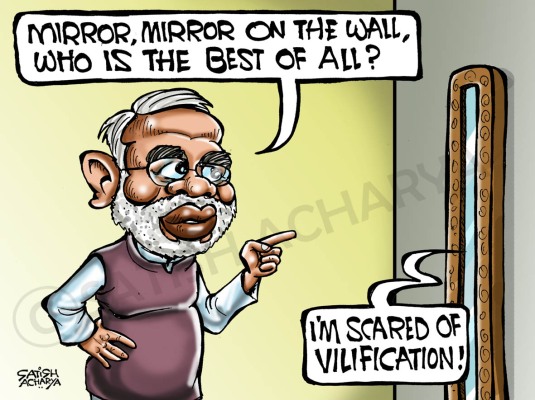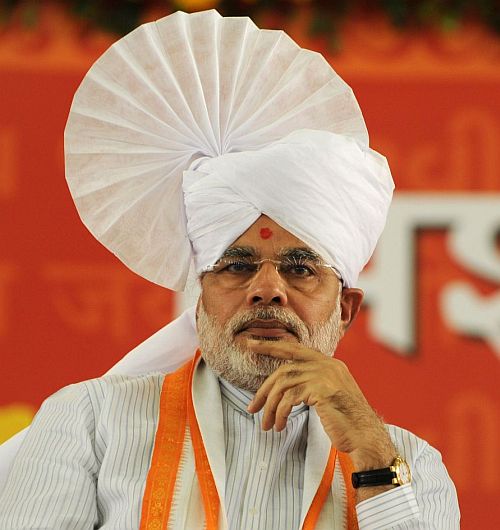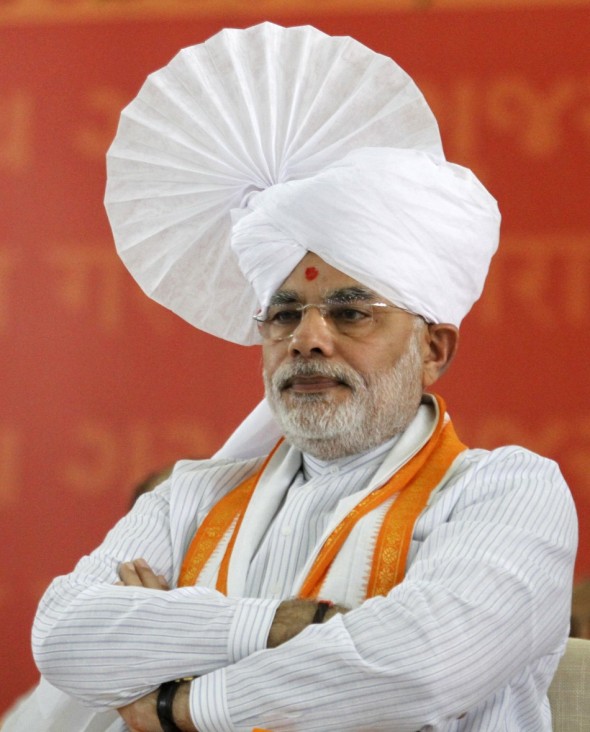
By P. K. Vijayan & Karen Gabriel
09 June, 2013
Countercurrents.org
The past few days have witnessed the grand spectacle of Narendra Modi emerging as the front-runner for the post of Prime Minister, from the Bharatiya Janata Party. Our growing sense of dismay and foreboding at this spectacle has however, led to some annoyance, the essential refrain of which is, ‘Why not Modi? Why are you so hostile to him? Look at what he’s achieved in Gujarat – maybe it’s time he was given a chance to do the same for India….’ We were immediately reminded of how we were met with the same response when Modi came to Delhi University on 6 February 2013, and we protested.
At the time, he had visited Sri Ram College of Commerce (SRCC) in the University, ostensibly to deliver a lecture on ‘vikas’ (progress) and ‘development’. We, along with many others, stood outside SRCC throughout his talk, protesting peacefully but vehemently against him. The Delhi Police repeatedly lathi-charged us, used water-cannoning, and (in open collusion with ABVP activists) indulged in extremely communal and sexually violent abuse and molestation of the female protestors. Nine of the protestors (including one of us) were gratuitously charged under various sections of the IPC and the Prevention of Damage to Public Property Act, 1984, with rioting armed with deadly weapons, obstructing public servants, assaulting public servants, damaging property, etc. That matter is pending investigation with the office of the Lieutenant Governor of Delhi.
Why did this happen? Because we protested against Narendra Modi. At that time too, several colleagues, students and sundry well-wishers expressed bafflement: while they were sympathetic to us for what had happened with the police, they couldn’t understand why we were protesting in the first place. After all, Modi was just coming to deliver a lecture on development, and, as they saw it, he too surely had the right to freedom of speech. What, they asked, was the harm in listening to him? The subtle, implicit accusation was, we had it coming – and on two counts: one, because we ‘hypocritically’ violated our own principles by seeking to deny Modi his freedom of speech; and two, because we protested his airing his views on ‘development’. Let’s deal with the second count first.
Presumably, we would have been forgiven if we had been protesting against Modi for making say, an explicitly communal speech, or defending the carnage of 2002. Not for one moment did it cross our interlocutors’ minds that Modi speaking on ‘development’ was, in fact the implicit defence of that carnage. Here was a man projected in several quarters, not least in the business community that SRCC is so strongly connected to, as the future Prime Minister of India. This ‘lecture’ was his first major public event since this projection began: did they seriously expect that he would come to make incendiary communal speeches, just when he is being projected as Prime Ministerial material now? Obviously not!
But does that mean that the Modi of Gujarat 2002 has vanished, because he won’t talk that way – or even talk about it? Has the man responsible for the deaths of Muslims on a scale tantamount to genocide suddenly been absolved of that sin because he now speaks only of ‘vikas’? And ‘vikas’ for whom? Blatantly corrupt corporates and business houses? There are reports that the Gujarat government has lost thousands of crores of rupees in land sold to industrial houses like the Tatas, Essar and the Adani Group way below its market cost. According to the Planning Commission’s Suresh Tendulkar Committee, Gujarat has the fastest growing poverty rate in the country. There is ample evidence to show that, on major indices of human development, taken individually and together, like literacy, life expectancy, infant mortality, etc., states like Maharashtra and Tamil Nadu have done far better than Gujarat – but there is no call to promote these states as models of development. 44.6% of children under five in Gujarat suffer from malnutrition; the maternal mortality rate stands at 172/lakh, which is extremely high; sex ratios are far below the national average; the poverty rate in tribal areas is as high as 57% – one can go on rattling off the figures, but the point is clear: ‘development’ in Gujarat is neither particularly phenomenal, nor has it touched the masses.
No, the reason why Gujarat is being promoted is because Modi has wooed and welcomed big business investment on an unprecedented scale in Gujarat. This means big funding for his party as well: the BJP will be suitably and generously rewarded by the Tatas and Ambanis who are being fawned on so assiduously by Modi. Combine this with his well-known ability to rabble rouse through war-mongering, hate-speech and general communal machismo, and you have a lethal new political soft pornography. It continuously suggests, without making any explicit connections, that Modi’s communal machismo is what is needed for genuine ‘vikas’. It weaves a general discourse of ‘development’ as rampant privatization, through which big business brings malls full of consumer goods, high-tech cities with gated colonies and huge inflows of foreign direct investments. Just as soft porn offers an endless supply of sameness disguised as variety, but incites desire for this nonetheless by perpetually presenting it as exclusive, yet tantalizingly available – so too, this model of development generates a powerful illusion of choice and promotes it as exclusive, privileged, available only through investment in the new economy. And Gujarat 2002 flickers through it as the subliminal hardcore pornography of this discourse – gutted houses, dismembered bodies, raped and murdered women, slashed wombs spilling chopped foetuses, terror-filled faces screaming for mercy.
These images of the full fury of state power unleashed provide an important, implicit and tacit guarantee to big business: that as long as Modi is in control, and in their pockets, they need fear no unrest from the masses they will oppress and exploit, because Modi’s state has shown that it is more than capable of acting without any restraint whatsoever – legal, ethical, moral or constitutional. The message is clear, and from all evidence, thrilling to large sections of the middle classes: if you want to enjoy the luxuries of ‘development’, as tailored by wholesale privatization, somewhat paradoxically, you need a state that shows itself to be strong enough to push that through – violently, vehemently, viciously. Economic might is made possible, and accompanied, by brute force, and the thrilling, ego-boosting, endless middle class desire for that might is fully fulfilled in Modi’s display of force. This is what marks Modi’s promotion of the same economic model practiced by the Congress, as different: the latter is perhaps as communal as the BJP, but it still hesitates to communalize these same economic policies as openly as Modi’s Gujarat did. Which also means that if the Modi model gains ground, the Congress will not hesitate to adopt it – effectively intensifying both the communalist and neo-liberalist tendencies that are already seeping through our socio-polity.
This is what we were protesting against. Modi on ‘development’ is not separate – and must not be separated – from Modi on Muslims/Christians/communists. Modi on ‘development’ is as dangerous and poisonous as Modi on the need for genocide. Promoting Modi in Delhi University was an audacious initiative, aimed at testing his acceptability in a space like the university that is, by definition, supposed to be a progressive, democratic, secular space. We now know better. The university not only gave SRCC consent to invite Modi, but also permitted the deployment of a huge police force on campus, armed not just with lathis and the occasional side-arm (as would have been the case in the not-too distant past), but astoundingly, with assault rifles, a water cannon and even a few machine guns! The university administration was clearly not only signalling acceptability to Modi, they were rolling out the red carpet of the bruised and beaten bodies of protestors for him. And if the university can be successfully sold the idea that Modi is selling ‘development’, and therefore will be allowed to address the university community, even if protest has to be openly and brutally crushed for that, then the rot has set in far more than we had gauged.
Which brings us back to the first allegation – that we are denying Modi the right to free speech, which we ourselves insist on so vehemently. The ingenuousness of this argument is matched only by its convenience. Modi is the last person who needs someone rushing to his defence, to exercise free speech or anything else. Let us for the moment forget that he has never himself been a defender of this right. Let us remember instead some other things we forget when we make such an argument. We forget that freedom of speech is no abstract, absolute freedom but has restrictions on it that are also constitutionally pressed. We forget that the right to protest against Modi is as much a matter of freedom of speech; Modi’s right in this regard is neither superior to, nor more valid than ours. We forget that freedom of speech is not just a legal provision but is above all a political provision. We forget that, as a political provision, freedom of speech must necessarily be understood and exercised in the political context in which it is invoked. (If this was not the case, and if freedom of speech was an absolute right, all forms of hate speech, obscenity and other inflammatory discourse could happily take recourse to this and spew venom with impunity.) In this case, the context is crystal clear: Modi the Hindutva leader was selling ‘development’ as his political ride, from a communal-fascist Chief Ministership to a communal-fascist Prime-Ministership. We protested against Modi’s coming, therefore, on principled political grounds, without hate-speech or obscenity – but that is what we were rewarded with by the police and Modi supporters.
It is true that in this particular instance, Modi’s lecture on ‘development’ was unlikely to attract any of the constitutional restrictions on free speech. But, as we have already argued, the political context is vital in understanding the limitations of free speech. Which is why, in a context in which Modi is being openly promoted as the next Prime Ministerial candidate from the BJP, Modi on ‘development’ is as sinister as the openly communal Modi. ‘Development’ is the Trojan horse that Modi (and the BJP) is hiding inside, to ride to Prime-Ministership This is what we were protesting against. And in the heart of Delhi University, we found a quick, small replay of what happened in Gujarat in 2002: the police joined hands with the supporters of Modi to wreak vengeance against the protestors. This is the sign of the India that will unfold under Modi, and this is what we were protesting against. What is at stake is the idea of India itself, and if that is an idea worth protesting about, then many more of us should be protesting against Narendra Modi.
Dr. Karen Gabriel, Assoc. Prof., Dept. of English, St.Stephen’s College, Delhi University. Dr. Karen Gabriel has been writing extensively on cinema, nationalism, gender, and sexuality. She has been actively engaging especially with questions of state violence, repression, democratic rights, etc.
Dr. P. K. Vijayan, Asst. Prof., Dept. of English, Hindu College, Delhi University. He has written on masculinity and nationalism, and has been actively involved in addressing the policy change in higher education initiated with Delhi University. They have co-authored several pieces on various issues.


















